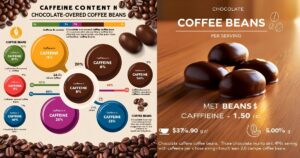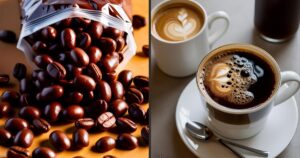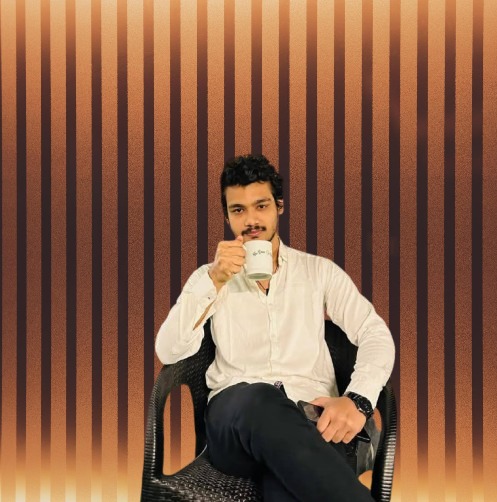Last updated on July 26th, 2025 at 05:19 pm
Ever popped a few chocolate-covered coffee beans thinking they’re harmless? You might be getting more caffeine than a full cup of coffee—without even realizing it.
Each chocolate‑covered coffee bean typically contains 6 to 13 mg of caffeine. Eat a handful—say 10 to 15—and you’re consuming up to 182 mg, nearly double the buzz of a regular 8 oz coffee.
But here’s where it gets tricky: the caffeine content isn’t consistent. It depends on the type of coffee bean (Arabica or Robusta), roast level, and even the chocolate coating—dark, milk, or white.
That’s why understanding exactly how much caffeine you’re eating is crucial—especially if you’re watching your intake or sensitive to stimulants.
In this guide, I’ll break it all down for you: exact caffeine amounts per bean and per serving, how they compare to other common drinks, what affects their potency, and how to enjoy them safely.
Let’s get into the facts—because knowing how much caffeine is in chocolate‑covered coffee beans could change the way you snack forever.
Caffeine Content Breakdown

Wondering how much caffeine is really packed into each chocolate-covered coffee bean? You’re not alone. Between the coffee bean itself and the chocolate coating, the actual amount varies more than you might think.
Let’s break it down so you know exactly what you’re getting with every bite.
Caffeine in the Coffee Bean
The bulk of the caffeine comes from the bean inside. But not all beans are created equal.
Arabica beans—used in most gourmet snacks—contain around 6 mg of caffeine per bean. They’re smooth and slightly sweet, but lower in caffeine.
Robusta beans, on the other hand, are bolder and pack nearly twice as much caffeine—often 10 to 12 mg per bean. They’re less common in chocolate-covered snacks but not unheard of.
And here’s something most people overlook: the roast level matters too. Lighter roasts retain more caffeine than darker ones. So if your snack uses lightly roasted Robusta beans, expect a serious jolt.
Sources like Era of We, Corner Coffee Store, and Eldorado Coffee Roasters back this up with lab-tested data.
Caffeine from the Chocolate Coating
Chocolate adds its own layer of caffeine—literally.
Dark chocolate contains about 80 mg of caffeine per 100 g. That breaks down to roughly 2 to 3 mg of caffeine per coated bean, depending on how thick the layer is.
Milk chocolate has far less—around 20 mg per 100 g, which means under 1 mg per bean.
White chocolate? Basically zero caffeine. So if you’re looking for a low-caffeine treat, that’s your go-to.
This subtle difference can add up fast, especially if you snack by the handful.
Brands like STARESSO, Dilettante Chocolates, and 5 Minutes for Mom have all confirmed these numbers across different product types.
Combined Estimated Range
When you add it all up, each chocolate-covered coffee bean typically delivers between 6 and 13 mg of caffeine.
That might not sound like much—until you eat 10 or more.
A standard 40 g serving (about 14–16 beans) can contain 84 to 182 mg of caffeine. That’s almost as much as two cups of coffee in one snack-sized bag.
According to Wikipedia, Corner Coffee Store, and STARESSO, this range depends heavily on bean type, roast, and chocolate.
So if you’re monitoring your caffeine intake, pay attention to the fine print—or better yet, count your beans.
Serving Size & Daily Intake

Chocolate-covered coffee beans might seem like a harmless snack, but they can quickly push your caffeine intake to surprising levels. Let’s break down exactly how many you can safely enjoy—and when it’s time to stop.
How Many Beans Equal a Cup of Coffee?
If you’re wondering how these beans compare to your morning brew, here’s the answer:
One 8 oz cup of coffee contains about 95 mg of caffeine.
Depending on the brand and coating, that’s roughly 6 to 8 chocolate-covered coffee beans.
That means just a few beans can equal your entire cup of coffee. Especially if they’re made with Robusta beans or dark chocolate coating.
Quick tip: If you’re reaching for that third handful, you might be powering through the caffeine equivalent of three cups of coffee without noticing.
Sources like Food Republic, ChocoVivo, and Healthline support these estimates based on average bean content.
Safe Consumption Limits
Now let’s talk safety. Even if you’re a caffeine veteran, there’s a limit to how much your body can handle.
According to the FDA and EFSA (European Food Safety Authority):
Healthy adults: Up to 400 mg of caffeine per day is considered safe
Pregnant women: Should limit intake to 200 mg per day
Teens: Should stay under 100 mg per day
So, how many chocolate-covered coffee beans is too many?
If each bean averages 10 mg of caffeine, a healthy adult could eat up to 30–40 beans per day—if no other caffeine is consumed.
But if you’ve had a coffee or soda already? Dial that number way down.
Guideline:
10–12 beans = Light pick-me-up (safe for most adults)
20–25 beans = Strong caffeine load (approaching max limit)
30+ beans = Caution zone—especially if combined with other sources
Sources: STARESSO, Eldorado Coffee Roasters, The Times
Factors Affecting Caffeine Levels
Not all beans—or coatings—are created equal. Here’s what makes the biggest difference in caffeine content.
Bean Type (Arabica vs Robusta)
Arabica beans are smoother and more common—about 6 mg of caffeine per bean
Robusta beans are stronger and more bitter—up to 12 mg per bean
Brands don’t always tell you what bean they use. But premium snacks often go with Arabica; budget options or high-caffeine products may use Robusta.
(Dilettante Chocolates, Eldorado Coffee Roasters)
Chocolate Type & Thickness
Dark chocolate coating = more caffeine
Milk chocolate = less
White chocolate = basically zero
The thicker the coating, the more caffeine is added from the chocolate itself. A dark chocolate shell could add 2–3 mg per bean alone.
Bean Size & Coating Amount
Larger beans = more caffeine
Heavier coating = more chocolate-derived caffeine
Some brands use oversized beans with thick coatings, boosting caffeine per piece well above average. That’s why 10 beans from Brand A could equal 20 from Brand B.
Read Also:
Comparisons: Chocolate‑Covered Beans vs Other Caffeine Sources

Not sure how chocolate-covered coffee beans stack up to your usual caffeine fix? Let’s compare them to coffee, tea, and chocolate so you can make smarter choices.
Caffeine Comparison Chart
| Item | Caffeine Content | Equivalent to Beans (~10mg each) |
|---|---|---|
| Chocolate-Covered Coffee Bean | ~6–13 mg per bean | — |
| Drip Coffee (8 oz) | ~95 mg | 9–10 beans |
| Espresso Shot (1 oz) | ~63–70 mg | 6–7 beans |
| Black Tea (8 oz) | ~40–70 mg | 4–7 beans |
| Green Tea (8 oz) | ~25–45 mg | 3–5 beans |
| Dark Chocolate Bar (100g) | ~70–90 mg | 7–9 beans (from chocolate alone) |
(Source: The Times, ChocoVivo, Coffee Forums, Allure)
Quick takeaway: Just 6–8 chocolate-covered beans can rival the caffeine in your morning coffee.
If you’re snacking mindlessly, you’re likely matching or exceeding your usual drink without even sipping.
Effects & Health Considerations
Eating a few beans might feel like a tasty energy boost, but the effects can be stronger—and longer lasting—than you expect.
Stimulant Effects of Caffeine and Theobromine
Each bean delivers more than just caffeine.
Theobromine, a compound found in chocolate, acts as a mild stimulant. While weaker than caffeine, it stays in your system longer.
This combo effect—from caffeine in the coffee bean and theobromine in the chocolate—can feel smoother but more sustained. You might feel:
A delayed energy spike
A longer-lasting buzz
Greater mental alertness with less crash
Especially true if you’re snacking on dark chocolate–coated beans.
(Source: Coffee Forums, Wikipedia)
Possible Side Effects & Sensitivity
Too much, too fast? It’s easy to go overboard.
Common side effects include:
Jitters or restlessness
Trouble sleeping
Increased heart rate
Upset stomach or nausea
Anxiety in sensitive individuals
Real-world example:
One user from 5 Minutes for Mom reported feeling jittery after eating just 3 beans—that’s only ~36 mg of caffeine. If you’re caffeine-sensitive, even small servings can trigger a reaction.
Timing Recommendations
Caffeine isn’t just about how much—but when.
Best time to eat chocolate-covered beans:
Morning to early afternoon (before 2–3 PM)
Avoid in the evening if you’re sensitive to sleep disruption
Pro tip:
Always check the label. Some premium snacks list caffeine content per serving, which helps you control intake better.
Practical Tips & Recommendations
To enjoy chocolate-covered coffee beans without going overboard, follow these practical guidelines:
Suggested Serving Ranges
5–10 beans = mild to moderate energy boost (~60–130 mg caffeine)
10–15 beans = strong boost (~100–180 mg caffeine)
20+ beans = high intake—may approach daily caffeine limits
Start small and track how your body responds.
(Sources: Era of We, STARESSO, Eldorado Coffee Roasters)
Check Nutrition Labels for Brand Variability
Not all beans are the same. Some brands—like Taza—have just ~3.75 mg per bean, while others approach 12+ mg.
Look for:
Caffeine per serving size (if listed)
Bean type (Arabica = less caffeine, Robusta = more)
Chocolate type (dark = more caffeine)
(Sources: Corner Coffee Store, Food Republic, Dilettante Chocolates)
Try Low-Caffeine or Decaf Brands
Want the flavor without the jitters? Look for:
Decaf chocolate espresso beans
Milk chocolate–coated options
Brands that use Arabica beans only
Perfect for late-night snacking or caffeine-sensitive users.
Homemade vs Store‑Bought
Making your own beans? Here’s how they compare to store-bought options.
Homemade Recipes Vary in Caffeine
You control the bean type, chocolate type, and coating thickness
Use Arabica beans + milk chocolate to reduce caffeine
Use Robusta + dark chocolate for a strong energy hit
DIY gives you flexibility—but you need to estimate caffeine levels carefully.
Brand Benchmark Examples
Taza: ~3.75 mg per bean (low caffeine)
L’orenta: ~8–9 mg per bean (moderate caffeine)
Eldorado: ~10–13 mg per bean (high caffeine)
(Sources: STARESSO, Food Republic, Eldorado Coffee Roasters)
Use brand benchmarks to choose a product that matches your energy needs.
Conclusion
Let’s recap.
Each chocolate-covered coffee bean has between 6 and 13 mg of caffeine.
A typical serving (14–16 beans) delivers 84–182 mg—equal to 1–2 cups of coffee.
Key takeaway:
Track how many beans you eat
Stay within your caffeine tolerance
Check labels, choose smart, and time your snacks right
FAQs
Q: How much caffeine is in one chocolate-covered coffee bean?
Most chocolate-covered coffee beans contain 6 to 13 mg of caffeine each. The exact amount depends on the type of coffee bean, roast level, and chocolate coating.
Q: How many chocolate-covered beans equal a cup of coffee?
A standard 8 oz cup of drip coffee contains about 95 mg of caffeine.
That equals around 6 to 10 beans, depending on the brand and bean size.
Q: Are chocolate-covered espresso beans as strong as coffee?
Yes—bean for bean, they can be just as strong or even stronger than brewed coffee.
They combine coffee bean caffeine with chocolate-derived caffeine, delivering a double boost.
Q: Can chocolate-covered beans affect sleep?
Absolutely. Eating them in the late afternoon or evening can disrupt sleep, especially if you’re sensitive to caffeine or theobromine (found in chocolate).
Stick to morning or early afternoon snacking.
Q: Are there decaf chocolate-covered coffee beans available?
Yes—some brands offer decaf versions or low-caffeine options. They’re a great choice if you enjoy the taste but want to avoid the buzz.

Shahriar brings a unique blend of storytelling prowess and digital expertise to Daily Coffee Guide. With a background in SEO and content strategy, he ensures our articles on Beans, Coffee, Tea, and Drinks are both engaging and discoverable. His passion for coffee culture drives him to explore and share the rich narratives behind every cup.

